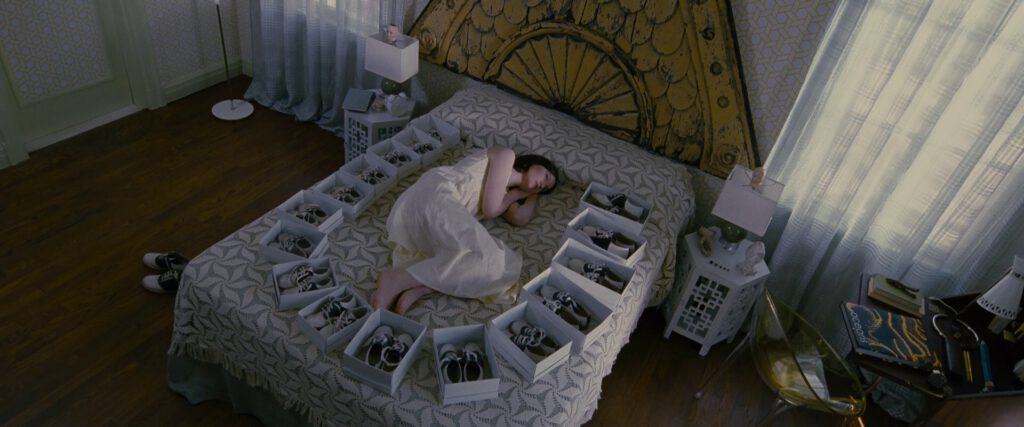Two Park Chan-wook films have their birthdays in 2023, but only “Oldboy” is partying under Neon lights. The muted 10th anniversary of Park’s “Stoker” was more similar to how its lead character’s 18th birthday begins in fiction: the sound of a car exploding, a woman screaming (“Richard! No!”), and then a funeral.
“Muted” would also be my feelings after my first viewing of “Stoker,” also known as Park’s debut in the English-speaking cinematic front. Without the holy sway of “Lady Vengeance” nor the hammer-hits of “Oldboy,” I felt the promise in the phrase “from the director of ‘Oldboy’” was missing. Its story about a young Conneticutian named India (Mia Wasikowska), coming into adulthood after the arrival of her elusive uncle, Charlie (Matthew Goode), left me cold. Even on the more superficial “abnormal household” grounds, the Stokers’ abnormality didn’t compel me to stare at a tree at the end. But it sure was well-made and visually breathtaking.
But the film has a helpful way to watch it, one I failed to register then: to see Charlie, India’s mother Evelyn (Nicole Kidman), and India herself as animals instead of humans. That one readjustment has manifested every note and pitch I initially thought was absent or lacking. It has also turned every subsequent film screening into a party, whether to an audience of one or many.

When I spoke with Park in late August for The Spool, as translated by Jiwon Lee, he validated this framing: “That indeed was my intention behind the characters.” Charlie is a wolf, Evelyn a moth, and India an original: these notions all work. And they will still work despite the caveat that also came from the filmmaker himself: “I don’t want to necessarily name a specific animal—all of it is metaphorical at the end of the day.”
Although it’s prominent that Charlie, who has made it his mission to get India toward imago, has serpentine traits, the character remains wolf-like. He likes to wrap around his target, whether to love—together with India completing an orgasmic piano duet, the sole trace of Philip Glass in the film’s score—or to kill, suffocating loose ends like Auntie Gin (Jacki Weaver), whose death scene features a camera shot that slithers alongside the murder weapon. Charlie’s eyes ooze danger and bloodlust, so stunning that the only possible response is to look back reflexively, even if they are sometimes behind sunglasses.
It is from Goode’s own windows to the soul that Park and writer Ted Foulke (pseudonym of Wentworth Miller) conduct their most successful exploration of the inner animal: What is being looked at also matters, or that function is as crucial as the feature containing it. Notable visuals highlighting Charlie’s eyes and the power of sight—and thus the deep connection between uncle and niece—appear early in the film, with a great example being the “cat and mouse” sequence at the wake for India’s father, Richard (Dermot Mulroney).

With an arc shot, Park fleetingly shifts the film’s gaze from Charlie in the foreground to India down the hallway when he spots her. Charlie has always had eyes on—and very likely for—his niece, but amid all the amoral chemistry and dark revelations, it’s easy to overlook how a layer of this attention stems from the grown Canis lupus’ understanding that its younger opposition is also one. Park would apply this technique to reveal truer-to-truth desires and objectives again in “Decision to Leave” in a scene involving mirrors and featuring another pair who shouldn’t be in love—and yet is. All of Park’s films are love stories at their cores, but none of the love depicted is conventional.
Evelyn is a more mythical kind of animal, considering how her wardrobe from Kurt & Bart allows her to never stay in one form. But while “Kidman as a kumiho” has a nice ring, the world of “Stoker” doesn’t need fantastical elements. That being said, what would be a more grounded and reasonable comparison? One that grants Evelyn hunting capabilities and gives credence to her ethereality (the hint is in Chung Chung-hoon’s camerawork—note how it will, near-reflexively, reserve so much space to capture her silhouette and movement)? How about a moth who can manipulate the flame?
Of everyone in “Stoker,” only Evelyn is severely affected by Richard’s death—fragile, aloof, and oversharing. Grief does make a soul the “odd one out,” but there’s reason to believe that Evelyn has always known how being delicate has its advantages. By being delicate, she receives the care she needs (from the housemaid Mrs. McGarrick (Phyllis Somerville) through inferred dialogues and from Charlie through all the visual devices). Or she gets to be warmer and brighter than her daughter to honor the gold in her hair and the summer in her wine. There’s a tragic, yet poetic, touch to this moth when its understanding of death is less having its breath taken away and more being rejected. While there’s little sense in being too close to the fire, Evelyn will be there if she finds a way to overtake India.
Yet, unfortunately for her, the effort to best an original animal like India will always be futile. If there is a horror element in “Stoker,” it is this (apologies to folks who are adamant the film was vampiric). As mentioned in the film’s beginning, which later reveals itself to be a part of the ending, India is present because she is the sum of her father, mother, and uncle—nothing the world has ever seen. Perhaps Charlie isn’t only liberating India; he’s also presenting biology with a new creation.

To regard India’s coming-of-age as inhuman is to pick up clues relating to Park’s “animal vision” for the film. There’s no reliance on nostalgia; if anything, it’s a curse that assumes the form of taxidermied animals around the house. The film is graded in either lilac or pale lavender, denoting an unusual way of seeing the surroundings—think a snake’s dichromatic vision—instead of the visuals of teen-aged memories. The road to growth also lies exclusively in observation through self-initiation from India or Charlie’s constant prompting.
There’s also the film’s other ending—not filmed for reasons unstated, but perhaps for the best because of its visuals. According to Park, viewers will see where India is heading with her Jaguar—her late father’s apartment in New York, the one meant for Charlie. She then pulls out her rifle, looks through its scope, and “hunts” passersby below. Again, despite the personal restraint to name any particular animal for the characters, Park said, “My idea behind [India’s] final transformation was that she grew into a bird of prey … [At this point] I think she has surpassed mankind or human ethical principles.”
Such an affirmation from the filmmaker has transformed, or corrected, the distant feeling I initially felt into one that I should have always hosted. The Stokers live in a gilded cage; the film’s “Do Not Disturb the Family” tagline might as well be “Do Not Disturb the Animals.” To be certain that the DNA of “Stoker” is both about becoming an adult and reaching the imago stage—this is the interpretation that sets me free.











